
|
Deaths Scenes 1930-1933 |

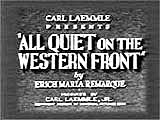
|
All Quiet on the Western Front (1930) In the unforgettable final moments of the film, just before the "all quiet on the western front" armistice and with all of his comrades gone, soldiers were bailing water out of a dilapidated trench. The faint sound of a harmonica could be heard. German soldier Paul Baumer (Lew Ayres) was sitting alone, daydreaming inside the trench on a seemingly peaceful, bright day. He was exhausted by terror and boredom. Through the gunhole of his trench, he saw a beautiful lone fluttering butterfly that had landed just beyond his reach next to a discarded tin can outside the parapet. He began to carefully reach out over the protection of his bunker with his hand to grasp it, momentarily forgetting the danger that was ever-present. As he stretched his hand out yearning for its beauty, a distant French sniper prepared to take careful aim through a scope on a rifle. As he leaned out closer to the butterfly and extended his hand, suddenly the sharp whining sound of a shot was heard. Paul's hand jerked back, twitched for a moment and then went limp in death. All was silent and quiet. The harmonica tune stopped. |
 The Soldier  The Sniper  Soldier's Hand Outstretched to Butterfly |
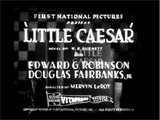
|
Once at the top of the underworld, the lonely dark figure of gangster Cesare Enrico 'Rico' Bandello (Edward G. Robinson) now wandered head down through the windswept city streets. Seeing a police car approaching, the slight figure of Rico went down to defeat and death in an unforgettable final scene. Police surrounded him as he fired a shot at the car and then hid behind a billboard with a gigantic poster (advertising Joe Massara and Olga Strassoff starring in a new dance show at the Grand Theatre: Tipsy, Topsy, Turvy - A Laughing Singing Dancing Success). Sgt. Flaherty (Thomas E. Jackson) threatened his ex-arch nemesis: "You'd better give up, Rico. You haven't got a chance," but Rico snapped back: "You want me, you'll have to come and get me." Rico was given one final ultimatum: "This is your last chance, Rico. Are you comin' out, or do ya want to be carried out?" The roadside billboard was raked with machine-gun fire, peppering the lower part of the poster across Rico's figure with bullets. Slowly, Rico fell and collapsed to the ground, his derby hat rolling off his head in front of him where he pathetically lay sprawled on the ground. The police stood above his body, as Flaherty asserted: "Well, Rico. It looks like you and I are going to take that little ride together." Rico looked up defiantly and disbelieving that he was about to die following the shoot-out ("No, no we ain't. I told you little buzzards like you will never put any handcuffs on me"). Flaherty responded: "You should have come out when I told you to, Rico." Rico painfully grabbed his sides and with a last gasp, moaned out his final words in a memorable death scene. He uttered his famous farewell epitaph with a weak voice, asking aloud:
The final shot dissolved into view. It contrasted the gritty scene of Rico's end behind the billboard with the front of the billboard, which extravagantly announced the escapist musical/dance show: "Tipsy Topsy Turvy." |
  Sgt. Flaherty    "Mother of Mercy! Is this the end of Rico?" |

|
The Champ (1931) The sentimental, sappy melodramatic film ended with the tear-jerking death of boxer Andy "Champ" Purcell (Wallace Beery) in the locker room. The film's focus was on the face of his young son Dink (Jackie Cooper) as he struggled with his father's oncoming death. Andy was knocked down three times and was urged to quit by Dink, but then landed a big punch and won, after taking a savage (ultimately fatal) beating in the match. He spoke his last words to his young son at his side:
|
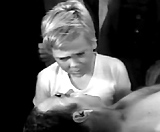  Dink (Jackie Cooper) With "Champ" Father |
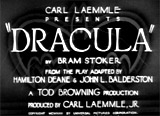
|
The death (offscreen) of vampire Count Dracula (Bela Lugosi) occurred when vampire-killer Van Helsing (Edward Van Sloan) drove a sharp, pointed wooden stake into the Count's undead heart, while he was sleeping in his coffin. It was a completely undramatic death scene:
|
  Dracula Staked to Death  Mina's Reaction  Van Helsing |
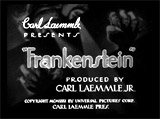
|
Quite shocking at the time was the Monster's (Boris Karloff) murder of young Maria (Marilyn Harris) by tossing her into a lake, thinking mistakenly that she would float like flower petals. In the film's most powerful, poignant, and horrifying scene, the Monster parted bushes and entered a clearing by the bank of the lake. He attempted to make friends with Maria who played there by herself. As she was gathering daisies at the edge of the water, she was not repelled by his hideous appearance or fearful of him and invited him to play and be her friend: "Who are you? I'm Maria. Will you play with me?" She took his hand and led him to the side of the lake. She asked: "Would you like one of my flowers?" and offered him one. A close-up of their two hands touching emphasized the enormity of his hands. With child-like innocence, he smelled the flower and a beatific smile lit his face. After they knelt next to the water, Maria handed him some flowers to join in her game of flinging them into the pond, and he compared his hand to hers: "You have those, and I'll have these. I can make a boat." One by one, they tossed flowers onto the surface of the lake, watching the petals float. "See how mine float?" The Monster delighted in the game with his new-found friend (his first) and was pleased when he threw a daisy and it floated. When the Monster's few flower blossoms were gone, he puzzled for a moment at his empty hands, and then innocently and ignorantly picked up Maria. The little girl screamed: "No, you're hurting me. No!" He enthusiastically threw her in the water - expecting that she, too, would float like the flower petals. She floundered and splashed in the water and quickly sank and drowned. As he staggered away from the lake, the Monster seemed to express some confusion, despair and remorse - shaking and wringing his hands and possibly perceiving the horrible thing he had done. |
    Playing a Deadly Flower Petal Game |
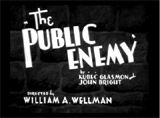
|
In a climactic scene, gangster Tom Powers' (James Cagney) bandaged dead body was special delivered to his home. The Powers home expected that Tommy would be coming home soon from the hospital after becoming seriously wounded. However, Tom's gangster boss Paddy Ryan (Robert Emmett O'Connor) reported that the Burns' gang had kidnapped Tom from the hospital. Paddy had negotiated to "quit the racket" if they let Tom go. Slightly later, a phone call to the Powers home reported that Tommy was indeed coming home. His mother (Beryl Mercer) cheerfully went upstairs and hummed to herself as she prepared his room for his home-coming: "Oh, it's wonderful. I'll get his room ready. I knew my baby would come home." A scratchy Victrola phonograph record played an upbeat tune, I'm Forever Blowing Bubbles on the soundtrack. In the rival gang's gruesome plan after kidnapping him from the hospital, they gift-delivered Tommy's bullet-ridden, rope- and blanket-wrapped 'mummified' corpse/body, announced by a knock on the door. When brother Mike (Donald Cook) answered the front door, Tommy appeared alive, bound from head to foot except for his exposed, bandaged and bloody face. It was the film's final memorable bone-chilling image - he tetter-tottered on the doorstep, and then his mummy-body fell and crashed with a dull thud - face-first onto the floor. The needle on the revolving phonograph record reached the end of the record, sounding like a heart-beat The film's somber message appeared over the image: The END of Tom Powers is the end of every hoodlum. 'The Public Enemy' is, not a man, nor is it a character -- it is a problem that sooner or later WE, the public, must solve. |
    Tied-Up Corpse Door Delivery |

|
Back Street (1932) There were two back-to-back deaths in director John Stahl's romantic, pre-Code 'weepie' melodrama about an ill-fated romance, and extra-marital and sacrificial love. The couple in an illicit yet long-lasting relationship with steadfast love and devotion were 'mistress' Ray Schmidt (Irene Dunne) and her 'taken' man Walter Saxel (John Boles), a successful financier-banker. She became the married man's permanent 'back street mistress' or make-believe wife - she was an alienated heroine outcast and kept tucked away joylessly in a cheap and tiny apartment while he was married to wife Corinne (Doris Lloyd) with two children. In the closing death sequence after Walter had suffered a stroke, his last thoughts turned to Ray - he could only say her name during his requested final phone call with her before he died. She replied to him: "Walter... yes, I'm here! I'm listening...I can't hear you, dear. What are you trying to say to me?" She intently listened (the phone receiver was set down) as Walter's son Richard "Dick (William Bakewell) reacted to the death: ("Dad, Dad! Nurse! Doctor!) and she heard the doctor's somber pronouncement: ("He's passed on"). Ray screamed out Walter's name in shock and begged: "Don't leave me!" and then collapsed to the floor. Following Walter's death, the tearful Ray sat in mourning in her shabby Parisian apartment, next to Walter's portrait. Walter's son visited Ray, and was now very sympathetic to Ray's feelings of true love and her dire plight. He explained: "His last thoughts were of you, Mrs. Schmidt." He was astonished to learn that she had been sustained or provided for by only $200/month ("You mean everything? Good heavens!"). Because she was not in Walter's will, he promised to continue to provide for her well-being. The film' powerfully visualized a direct connection between Walter (represented by a head-shot of his portrait next to her) and Ray when she spoke to him about how nice Richard had been to her, and their missed opportunities together: "Your son is going to take care of me. He was so nice. He might have been my son, our son. I wonder, Walter, what would have happened if I'd met your mother that day in the park." Desperate to be with Walter, she retreated into fantasy and replayed in her mind that she had actually met his mother (Maude Turner Gordon) at a local band concert in the park, who greeted her warmly: "So you are Ray Schmidt. You are nice. My dear, you are all he said you were. And I hope you both will be very happy." In the film's final moments, Ray was able to transcend time and any other barriers (social and physical) that stood between them -- she murmured: "I'm coming, Walter, I'm coming" and succumbed (by slowly bowing her head onto the table holding Walter's portrait). |
    Walter's Dying Phone Call to Ray   Ray's Mourning of Walter's Death   Fantasy of Meeting His Mother Visualized  "I'm coming, Walter, I'm coming" |
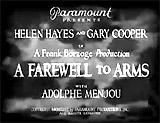
|
A Farewell to Arms (1932) The quintessential deathbed scene in this tearjerker was one of the most romantic and sad ever filmed. British nurse Catherine Barkley (Helen Hayes) died in her hospital bed in a maternity ward in Switzerland after her baby died -- with loving World War I officer and ambulance driver Lt. Frederic Henry (Gary Cooper) by her side kissing her and professing his love ("I'll never stop loving you"). She experienced a prolonged tearjerking death:
It coincided with bells ringing to declare the Armistice. After she died, he carried her in his arms to the window and affirmed: "Peace, peace" - as white doves flew into the air and the screen faded to black. |
 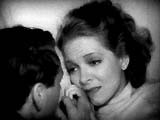    "Peace, Peace" |

|
Vampyr (1932, Fr./Germ.) (aka The Vampire, or Castle of Doom) Danish director Carol Theodor Dreyer's first sound film - about vampyres (although with sparse dialogue and still employing title cards), was a slow-paced, unsettling psychological horror masterpiece with German expressionistic camerawork and soft-focus images - many about death. During a feverishly dreamy, disorienting scene, occult researcher Allan Gray (Julian West, aka Baron Nicolas de Gunzburg), a specialist who studied "devil worship and vampire terror" and had been drained of his blood, became ghostlike and spiritually transparent (filmed with double-exposure as he rose up from a bench). He viewed his own death as a disembodied soul, beginning with a view of his own body on a flower-bed in a coffin. In a five-minute sequence of being buried alive, the film's most heralded and celebrated set-piece, the hero found himself sealed in the glass-windowed coffin and watching what was enfolding from his body's own claustrophobic, helpless subjective point-of-view:
He then defeated the vampyr when he went to the cemetery, opened the grave of Marguerite Chopin, pounded a thick iron bar through her body and heart (her face turned skeletal), and lifted the curse. In the concluding sequence village doctor (Jan Hieronimko), one of the vampyre's minions, died from suffocation while hiding in the bottom of a flour mill where the activated machinery buried him alive under mounds of white flour. |
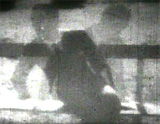 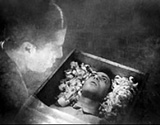 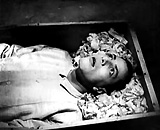 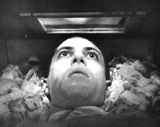 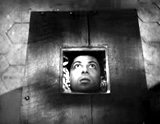 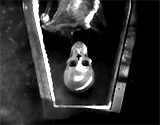 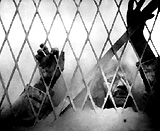
|

|
King
Kong (1933) There was a thrilling and traumatic death scene in this classic adventure film, when the giant ape King Kong was attacked by biplanes while atop the Empire State Building in NYC. Kong clutched the girl Ann (Fay Wray) whose blonde beauty had touched his heart. He placed Ann on a ledge and then roared in defiance at the planes. A squadron of fighter biplanes swirled around him in an attack to shoot him down, as he swatted at them like irritating mosquitoes or bees, but he couldn't reach them. His battle against the biplanes was futile. Kong flinched as machine gun bullets ripped into his body. Kong sent one careless pilot to a fiery death. After a vicious attack into his throat and body, he was weakened and knew that he was dying. He touched his wounded chest, and then examined the blood on his fingers from the wound. He wiped his forehead with the back of his hand. He gently picked Ann up one last time to gaze at her with tender affection and love. Then, he returned her to the ledge and stroked her gently with his fingertips. After another volley of bullets into his throat, his head drooped and his body swayed and staggered - he was barely able to hold on. When he loosened his hold from the building, he silently plunged many stories to his death on the street below. Tragically, Kong was no longer an object of terror and fear, but of pity. Moments later, Ann was rescued by Jack Driscoll (Bruce Cabot) on the Empire State Dome. He embraced his fiancee tightly in his arms: "Ann, Ann, hang on, dear." In the final coda scene on the street's pavement below, next to Kong's lifeless body that was sprawled there with blood trickling from his mouth, film-maker Carl Denham (Robert Armstrong) pushed his way through the police cordon to examine the massive, crushed body of the fallen monster:
He corrected the police officer lieutenant who claimed he knew what killed Kong. Rather than the 'airplanes' - a symbol of civilization, Denham stated what finally 'killed the Beast.' He shook his head and replied with assertive relish, in a classic line - the final line of the film:
|
  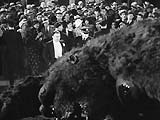 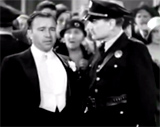 "... It was Beauty killed the Beast." |
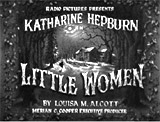
|
In a sad scene, dying Beth March (Jean Parker) reassured her older sister Jo (Katharine Hepburn):
Jo wrote an ode to her sister, titled "My Beth":
Beth's last words were: "I think I can sleep now. Oh look, Jo. My birds. They got back in time." At the moment of Beth's death - birds flew off from the window sill. |
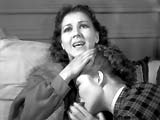 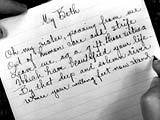 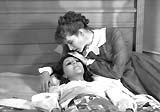 Jo with Dying Sister Beth |

|
Only Yesterday (1933) Director John Stahl's pre-Code romantic, soapish tearjerker melodrama was about an unwed single mother named Mary Lane (Margaret Sullavan in her film debut) who had a relationship over a 12 year period (from 1917 to 1929) with war veteran and unhappily-married Wall Street banker James "Jim" Stanton Emerson (John Boles). Their story was told in flashback during his reading of her deathbed letter to him - written by a woman from his past that he was unable to remember. Their relationship began twelve years earlier - when he had a one-night stand in a moonlit garden setting during an officers' ball-dance in Virginia with her - as 19 year-old southern belle Mary. It was on the eve of his departure to serve in the Great War in 1917. When he returned from the war and she had already borne him a son, she tried to greet him and get reacquainted during a ticker-tape parade, but without realizing who she was, he turned and embraced female acquaintance Helen (Mabel Marden) and then his own fiancee Phyllis (Benita Hume) - and there was a long close-up and shock of disappointment and hurt that registered on Mary's face. By the film's conclusion, Mary experienced a lingering death from a chronic heart ailment after she had penned the final words of the letter (to be mailed to Emerson by her aunt Julia (Billie Burke) following her death). She was calling out to her 11 year-old son Jimmy, Jr. (Jimmy Butler) to come to her bedside: ("Jimmy! Hurry darling! Julia, why doesn't he come?...I mustn't go yet. I must wait for him...Doctor, Doctor, I'm getting weaker, I don't want him to see me like this. Can't you do something?"). She spent her final moments with Jimmy, dressed up in his military uniform: ("I've got to go away for quite a long time, and I want you to promise to be as good a boy when you're big as you have been to mother when you were little. Darling, don't cry"), and soon after died (off-screen). In the film's ending, Emerson read the end of the letter that revealed he had fathered a son by her: ("...and now goodnight, my dear. I should have never told you all this except for your son -- go and see him -- I know you will love him. God bless and keep you both. Yours, Mary Lane"). He rushed to her apartment, but she had already died. He comforted Jimmy, Jr., and then confessed that he was Jimmy's father - and the boy's tremulous response: "My father?" - as the film abruptly ended. |
 Jim Emerson Reading Mary's Deathbed Letter   Mary's Lingering Death  Last Words With Son Jimmy Jr.  "My father?" |
(chronological by film title) Intro | 1915-1929 | 1930-1933 | 1934-1938 | 1939 | 1940-1942 | 1943-1945 | 1946-1947 | 1948-1949 1950-1952 | 1953-1955 | 1956-1957 | 1958-1959 1960-1961 | 1962-1963 | 1964-1966 | 1967-1968 | 1969-1970 1971 | 1972 | 1973 | 1974 | 1975 | 1976 | 1977-1978 | 1979 1980 | 1981 | 1982 | 1983 | 1984 | 1985 | 1986 | 1987 | 1987 | 1988 | 1989 1990 | 1991 | 1992 | 1993 | 1994 | 1994 | 1995 | 1995 | 1996 | 1997 | 1998 | 1998 | 1999 2000-2001 | 2002 | 2003 | 2004 | 2005 | 2006 | 2007 | 2008 | 2009 | 2010 | 2011 |